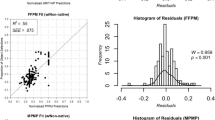Abstract
Latent partition analysis enables an examination of the modal population categorizations of a set of items. The initial model proposed by Wiley is reformulated, extended and generalized. Firstly, the effects of judges are regarded as random, rather than fixed. In a second model, several latent partitions, rather than one, are allowed, resulting in a type of multidimensional approach. Finally, both the single and multiple partition models are shown to be specializations of a less restrictive model, called the category focusing model. In each of these three cases, properties implicit in the model are used to derive appropriate solution procedures.
Measures of individual differences are considered, and the application of the procedure to experimental work in concept formation is discussed. Several sets of data are used to demonstrate the characteristics of the techniques evolved.
Similar content being viewed by others
References
Bartlett, M. S. A note on the multiplying factor for variousx 2 approximations,Journal of Royal Statistical Society B16, 1954, 296–298.
Bower, G. H. and Trabasso, T. R. Concept Identification. In R. C. Atkinson (Ed.)Studies in Mathematical Psychology. Stanford, Stanford University Press, 1964.
Ericksen, S. C. Studies in the abstraction process.Psychological Monographs, 1962, 76, 18, No. 537.
Harman, H. H.Modern Factor Analysis. Chicago, University of Chicago Press. 1967.
Harris, C. W. & Kaiser, H. F. Oblique factor analytic solutions by orthogonal transformations.Psychometrika, 1964,29, 347–362.
Joreskog, K. G.Statistical Estimation in Factor Analysis. Stockholm, Almqvist and Wicksell. 1963.
Kaiser, H. F. The application of electronic computers to factor analysis.Educational and Psychological Measurement, 1960,20, 141–151.
Kaiser, H. F. & Caffrey, J. Alpha Factor Analysis.Psychometrika, 1965,30, 1–14.
Lawley, D. N. The estimation of factor loadings by the method of maximum likelihood.Proceedings of the Royal Society of Edinburgh, Section A, 1940,60, 64–82.
Mandler, G. & Pearlstone, Zena. Free and constrained concept learning and subsequent recall.Journal of Verbal Learning, 1966,5, 126–131.
Wiley, D. E. Latent partition analysis.Psychometrika, 1967,32, 183–194.
Author information
Authors and Affiliations
Additional information
This project was commenced while the author was on the staff of the University of Queensland.
Rights and permissions
About this article
Cite this article
Evans, G.T. The analysis of categorizing behavior. Psychometrika 35, 367–392 (1970). https://doi.org/10.1007/BF02310795
Received:
Revised:
Issue Date:
DOI: https://doi.org/10.1007/BF02310795




